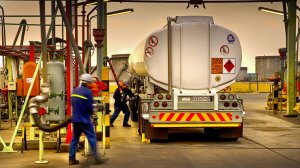The International Maritime Organisation (IMO) 2020 regulation has prescribed for a large reduction in the maximum sulphur content of bunker fuels which presents a challenge for South African oil refineries.
Industry body the South African Petroleum Industry Association (Sapia) strategic projects head Kevin Baart says the current permissible maximum fuel oil sulphur limit of 3.5 weight per cent will fall to 0.5 weight per cent for those vessels using bunker fuel not equipped with scrubbers.
Notably, the South African bunker market has dropped with Durban moving about one-million tons per annum whereas it used to be more than double that about ten years ago. Cape Town has also seen reduced bunker volumes. Refiners will need to adjust to these developments – reduced sales and the sulphur cap.
Baart tells Engineering News that there is no local regulatory mechanism currently in place to accommodate this IMO development, although the Department of Transport has committed to establishing one. Subsequently, the South African Maritime Safety Authority issues Marine Notices from time to time to give direction and assurance to the shipping industry that they are ready for implementation. Nevertheless, the oil industry will provide IMO 2020 compliant bunker fuel oils to the market.
“For IMO 2020 to succeed, it will require a learning period for refiners in terms of the production of bunker oil and the consumers of the product.”
Sapia will observe, with keen interest, how this adjustment will be rolled out. Baart suggests that this might be achieved by either importing more sweet crude oil to produce the bunker fuel, importing more gas oil or increasing the exports of high-sulphur fuel oil.
“This could mean a potential increase in supply chain tightness,” he adds.
Further, oil refineries have to comply with the minimum emission standards (MES) as stipulated in the national Air Quality Act.
While these guidelines are primarily managed by the localities in which the refineries operate, they do abide by the MES, says Baart.
From a greenhouse gas emissions perspective, “refineries contribute a small part of the greenhouse-gas emissions in the country – the biggest contributors are the power stations. The major emitters of a refiners’ products are motorists and the only way to improve that is to offer them cleaner fuels”.
“Manufacturers are hesitant to invest to produce cleaner fuels, as it does not provide a return on investment for them,” he points out.
He also highlights that any incremental investment towards cleaner fuels cannot be achieved without government support. This is “extremely essential” because, if local refineries are not able to produce cleaner fuels, they may be forced to shut down.
Moreover, Baart advances that South African refineries are well maintained and operated.
“To suggest that they are old is a misnomer because it does not take into account the ongoing refurbishment both in terms of adopt- ing new technology and equipment within the refineries.”
Edited by: Zandile Mavuso
Creamer Media Senior Deputy Editor: Features
EMAIL THIS ARTICLE SAVE THIS ARTICLE
ARTICLE ENQUIRY
To subscribe email subscriptions@creamermedia.co.za or click here
To advertise email advertising@creamermedia.co.za or click here















